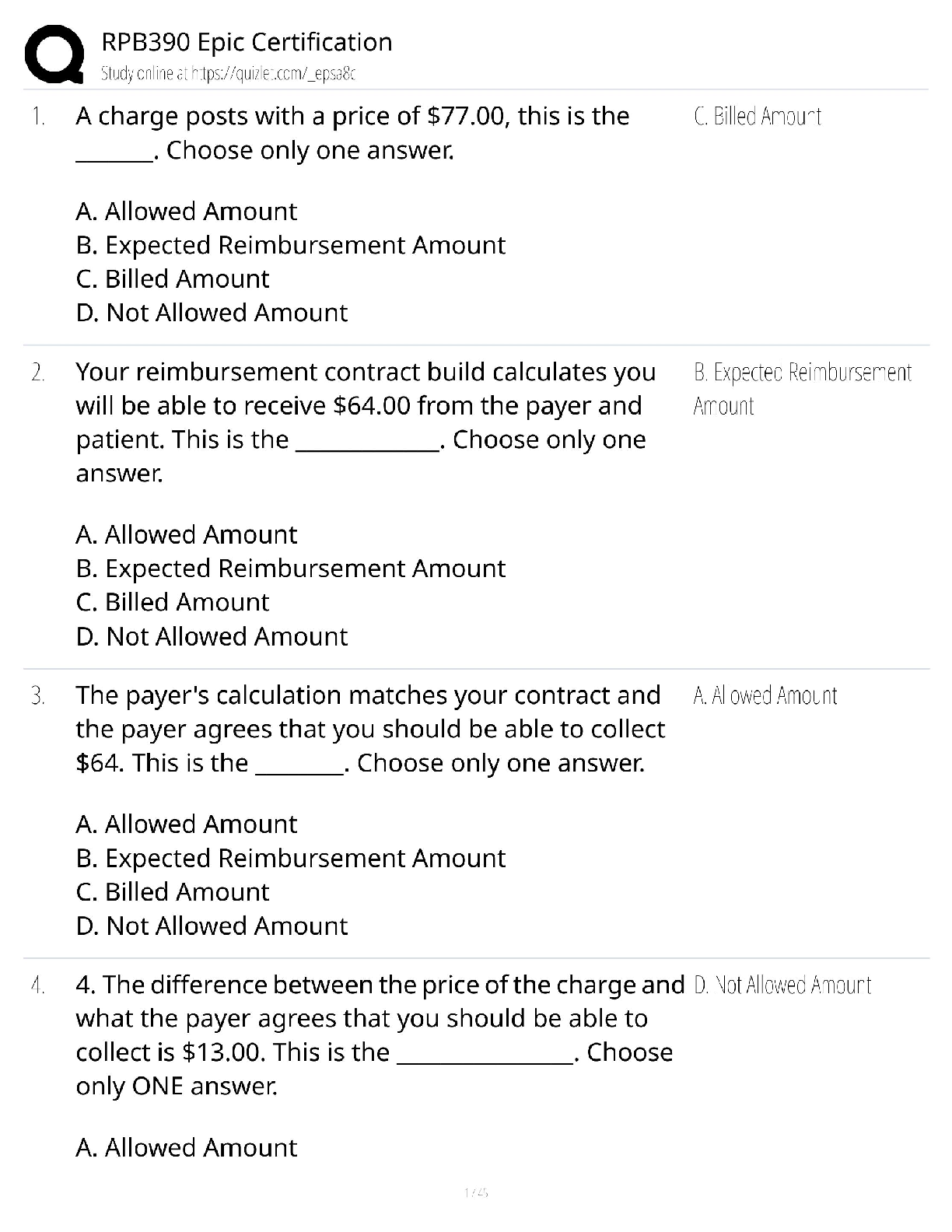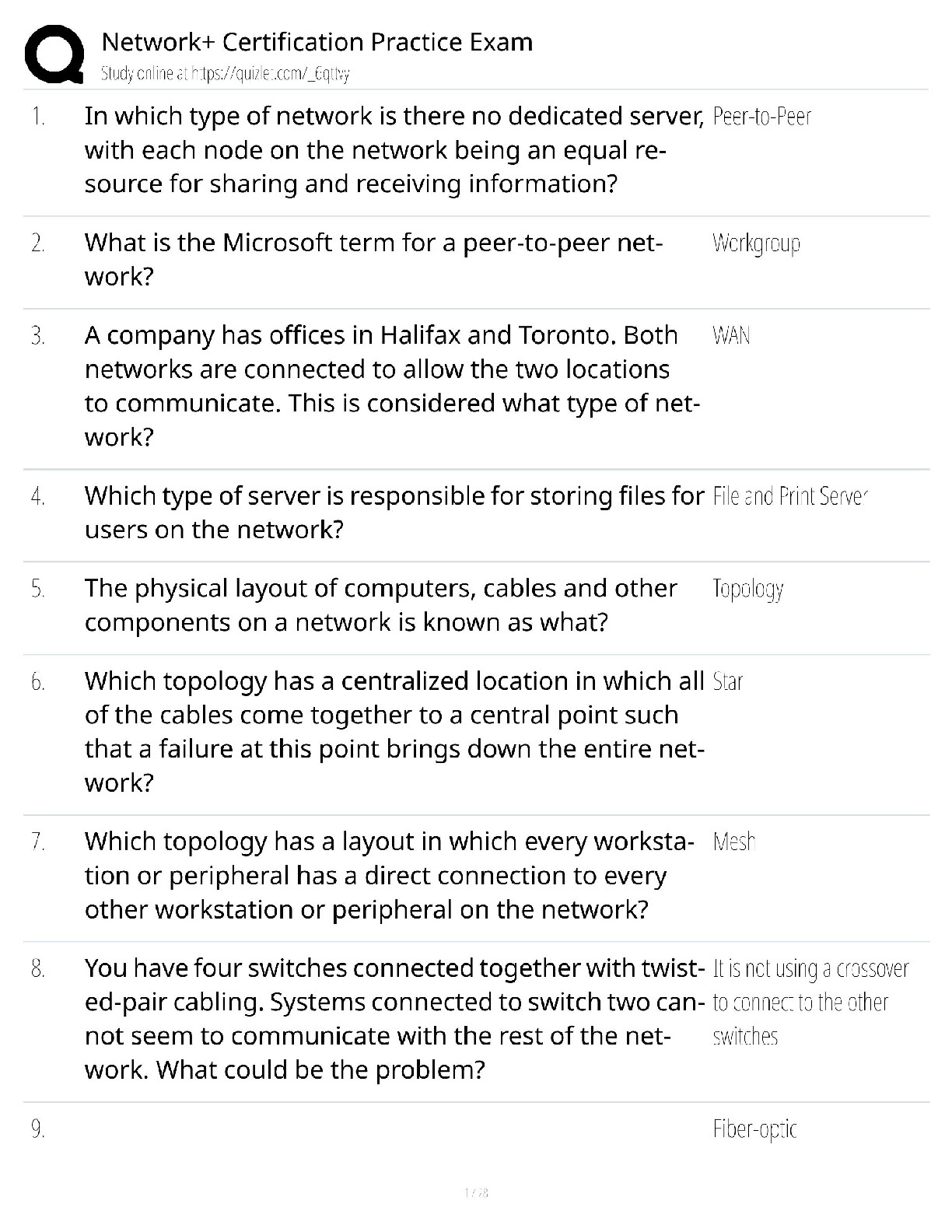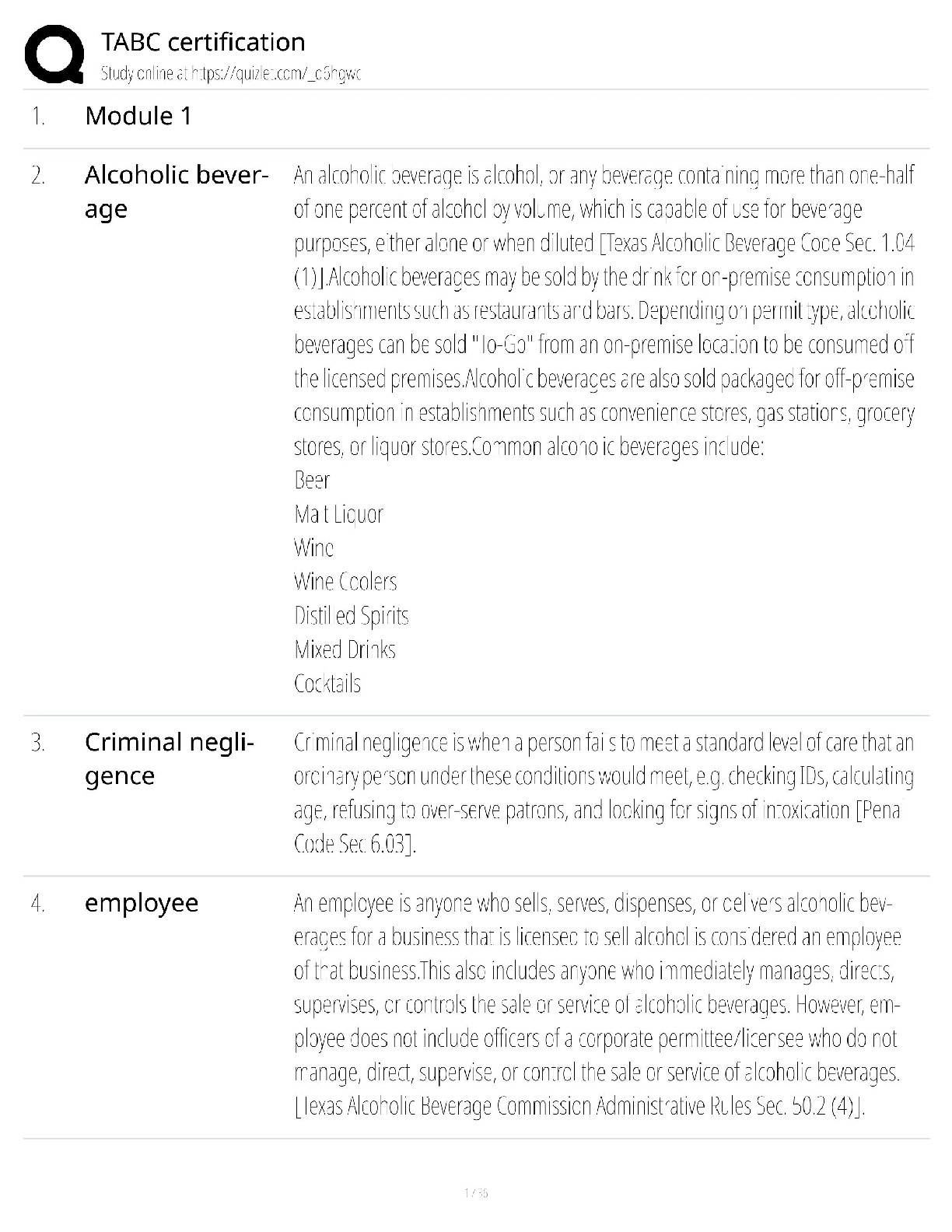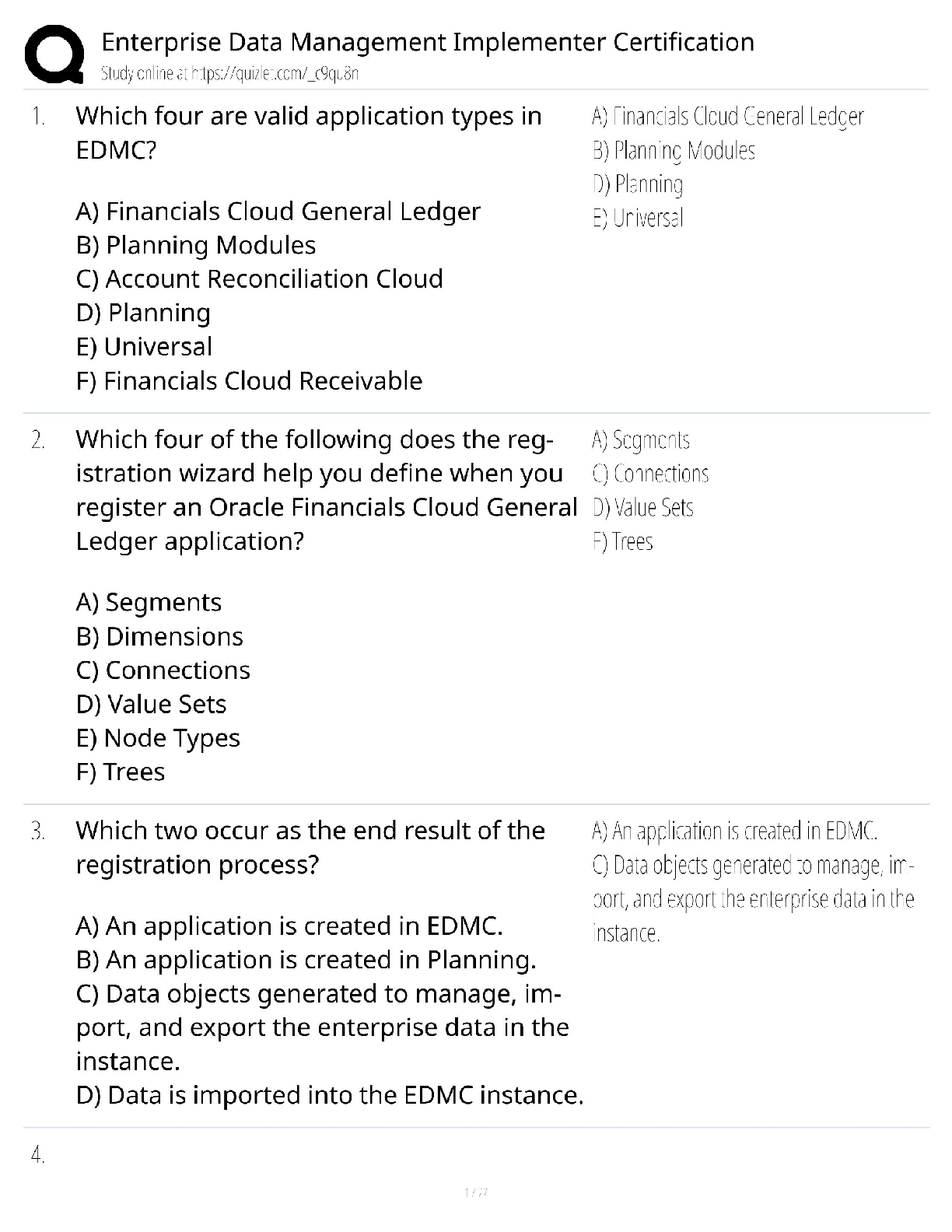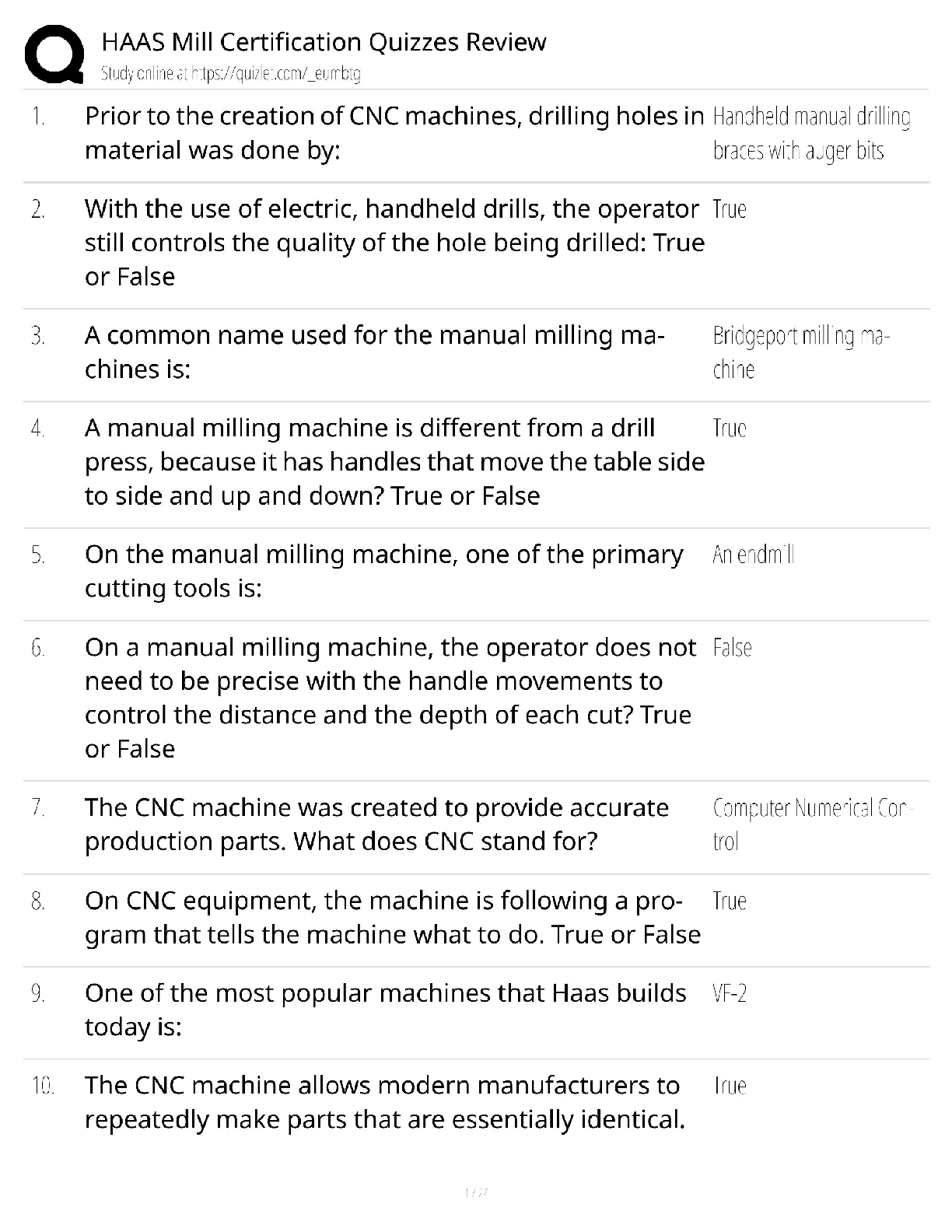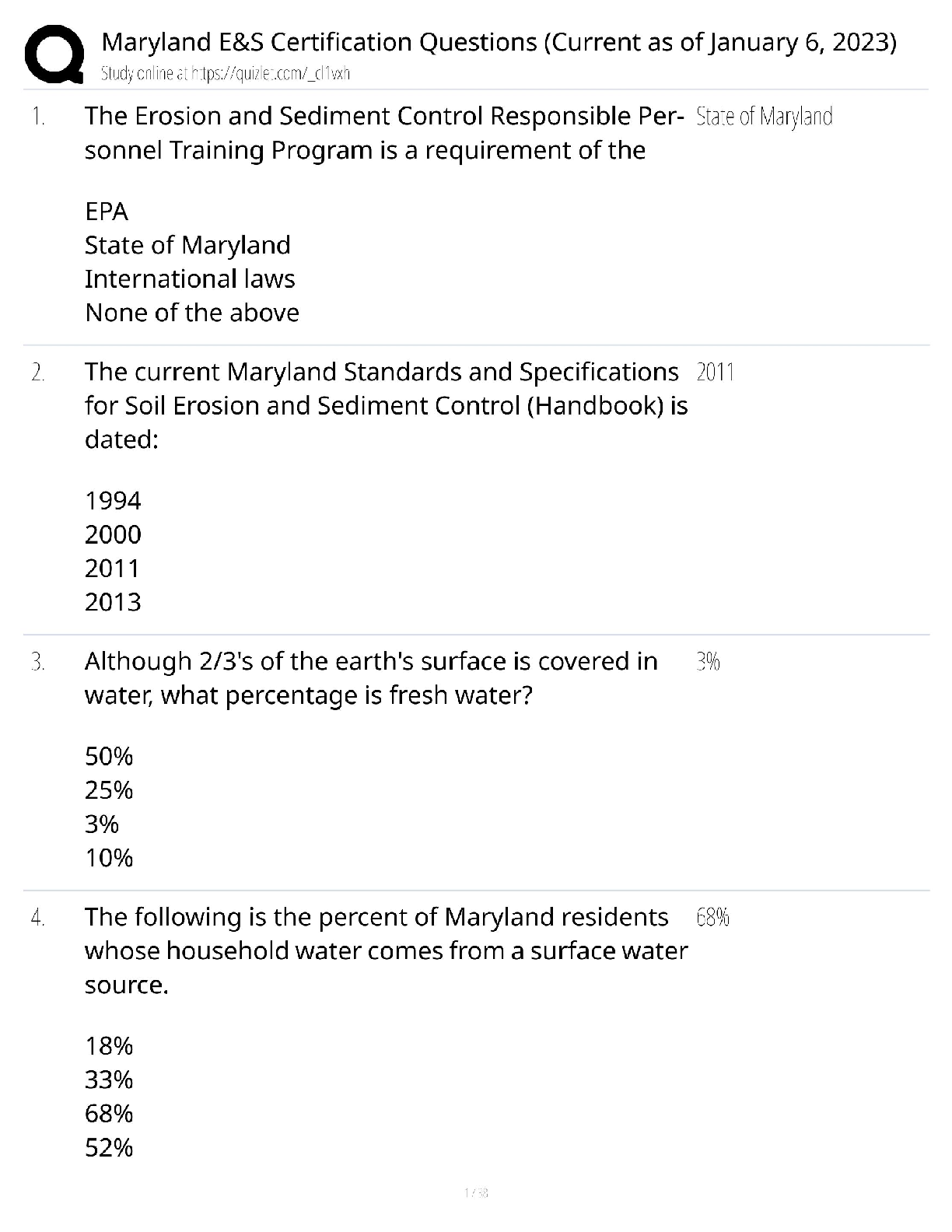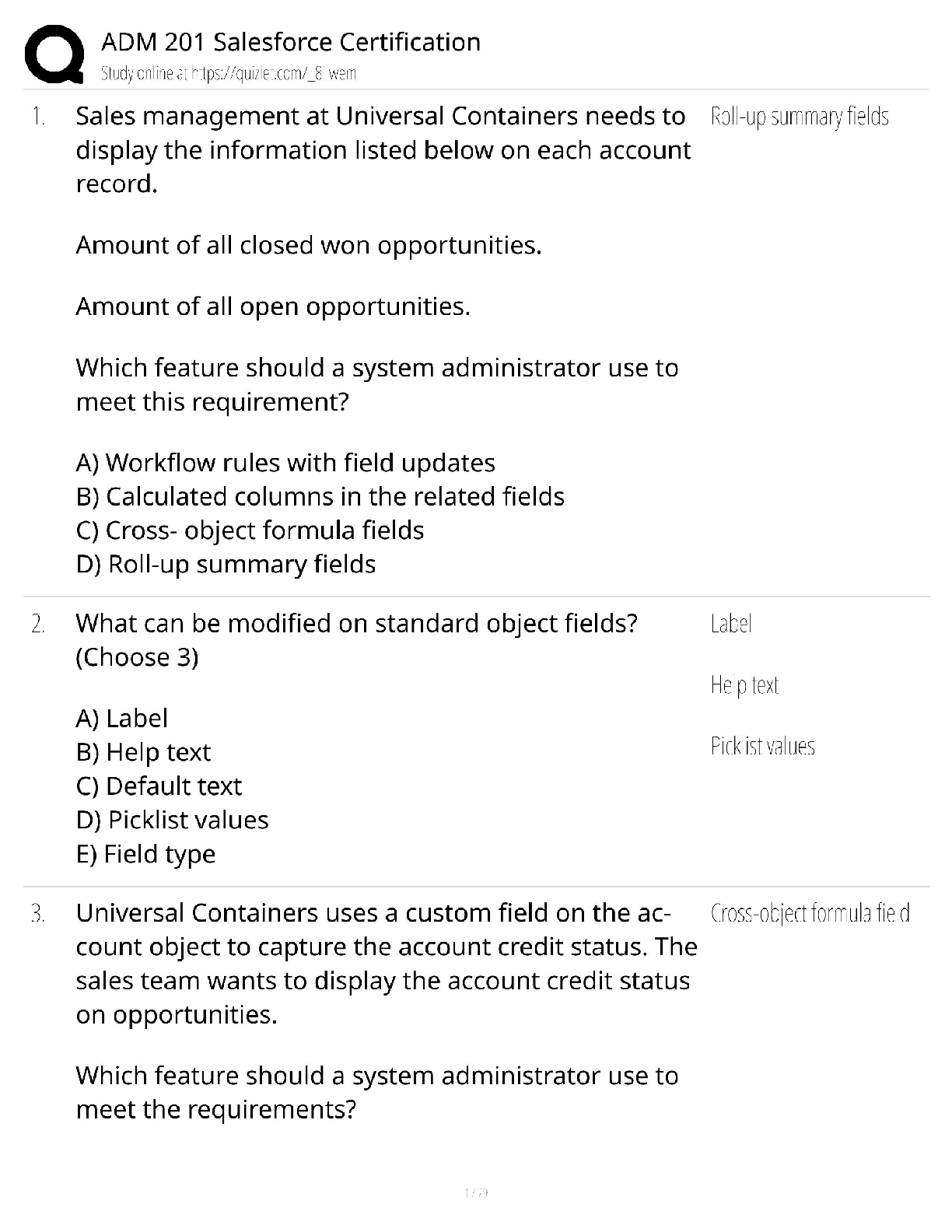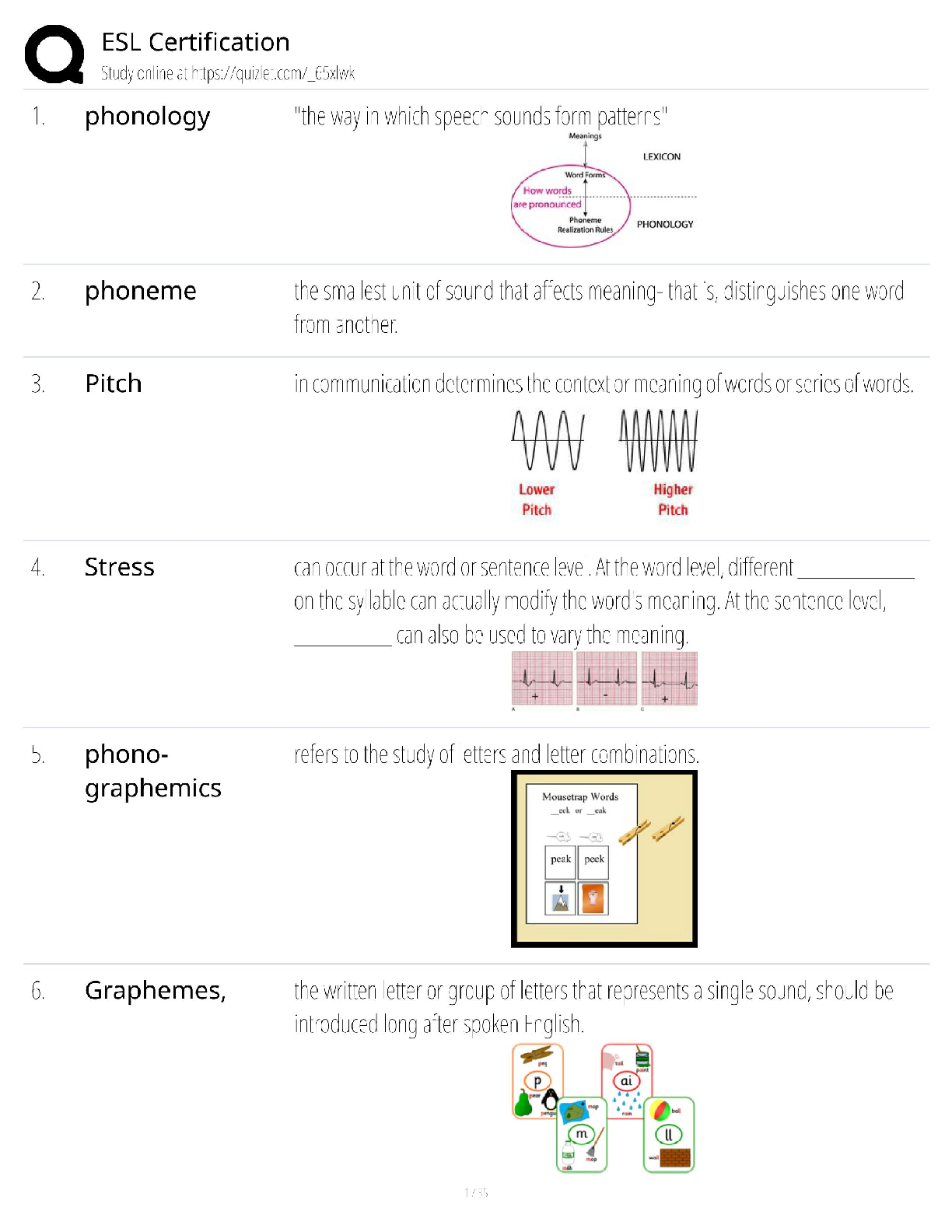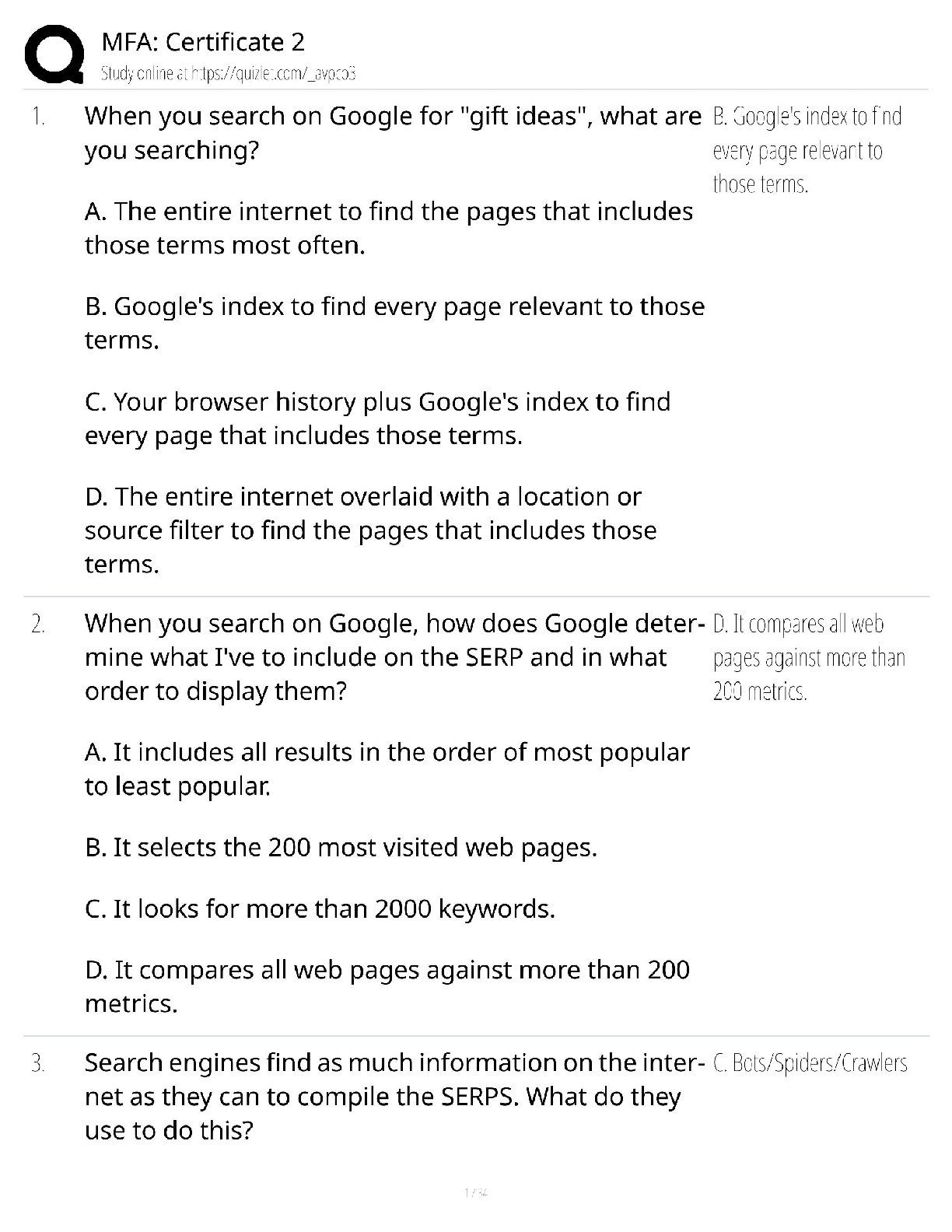Finance > QUESTIONS & ANSWERS > CFA LEVEL 1 Examinable Questions with answers,2021/2022. Graded A+ (All)
CFA LEVEL 1 Examinable Questions with answers,2021/2022. Graded A+
Document Content and Description Below
CFA LEVEL 1 Examinable Questions with answers,2021/2022. Graded A+ Financial Statement Analysis Framework - ✔✔provides an overview of the methodology used by analysts to consistently analyze fi ... nancial statements 1. articulate the purpose and context of analysis 2. collecting data 3. process the data 4. analyzing and interpreting the processed data 5. develop/communicate conclusions and recommendations 6. follow up Scope of Financial Statement Analysis - ✔✔- analysis is based on financial statements is performed by equity investors interested in valuation, lenders interested in liquidity, suppliers interested in future business, and analysts working to recommend security purchases, mergers, credit and lending, debt ratings, and forecasting Balance Sheet - Assets - ✔✔- assets are items owned by a company that will benefit the company in the future - found on balance sheet; include current/noncurrent - required to be listed separately under IFRS - typically shown on balance sheet at historical cost Income Statement - Introduction - ✔✔- reports revenues, expenses, and profit or loss for a company on a consolidated basis over a short period of time - revenues are matched with expenses incurred to earn the revenue, and the net result is a profit or a loss for the period - when the company reports on a consolidated basis, they include all companies they own in one income statement Statement of Changes in Equity (1) - ✔✔- reconciles the balance in equity from the beginning of a period to the end of a period - equity is composed of paid-in capital, retained earnings, other comprehensive income, and minority interests - statement of changes in equity reconciles the beginning equity balance with the period-ending equity balance by analyzing the changes in the four components of equity Beginning equity +/- increase/decrease in paid-in capital + net income (or minus net loss) - dividends paid +/- changes in other comprehensive income +/- changes in minority interest Balance Sheet - Liabilities - ✔✔- future obligations of a company, which may be monetary or non-monetary - include current/non-current liabilities - required to be listed separately under IFRS as a means of helping analysts in identifying threats to liquidity Financial Notes (footnotes) and Supplementary Schedules - ✔✔- required part of the financial reports and contain essential information about the company's accounting policies, methods, and estimates, many of which are essential for analysis Statement of Comprehensive Income - ✔✔- requirement under IFRS - comprised of both profit and loss for the period and other items affecting equity - presented as one or two statements, with one being the income statement - includes the traditional statement of operations and a second component presenting items that affect owners' equity but are not share transactions - component is called Other Comprehensive Income (OCI) - OCI reports certain gains and losses that bypass the income statement and end up as adjustments to owner's equity - OCI includes fair value changes, items reclassified to profit and loss, and other non-owner changes in equity - AOCI is included as a separate line item in the equity section * US GAAP allows corporations to present OCI as part of the statement of changes in equity as opposed to being part of the comprehensive income statements Management Discussion and Analysis - ✔✔- provides readers with information needed to understand a company's financial condition, changes in financial condition, and results of operations 5 Elements 1. nature of the business 2. management's objectives and strategies 3. company's significant resources, risks, relationships 4. results of operations 5. critical performance measures Auditor's Reports - ✔✔- performed by qualified, independent auditors - opinion is based on the audit procedures performed that are designed to provide reasonable assurance the statements fairly present the results of operations and financial condition of the company in accordance with applicable accounting standards - opinions may be unqualified, qualified, adverse, or disclaimed Introductory Paragraph - sets forth the statements to be audited and the responsibilities of both management to prepare the statements and auditors to audit the statement Scope Paragraph - describes the nature of the audit process and procedures that serve as a basis for the auditor's opinion Opinion Paragraph - states the auditor's opinion concerning if the statements fairly present the company's financial position and result of operations free of material misstatements in conformity with applicable accounting standards Auditor's Opinions - ✔✔Unqualified Opinion - (most common) auditor found no material misstatement and believes the statements fairly reflect the results of operations and financial condition of the company, in compliance with applicable accounting standards Qualified Opinion - auditor found something material that does not comply with the applicable accounting standards; this exception doesn't invalidate the statement as a whole, though, and the auditor will explain the qualification in the audit report Adverse Opinion - the auditor found material misstatements of such an extent that the statements taken as a whole do not fairly represent the results of operations and financial condition in compliance with applicable accounting standards (really rare) Disclaimer of Opinion - auditor cannot complete the audit, not issuing an opinion; also rare *required under U.S. GAAP to express opinion on company's internal control system (not required under IFRS) Cash Flow Statement - Introduction - ✔✔- reports the cash generated and expanded during a fiscal period - statement of cash flow differs from an income statement in that it converts all the transactions into cash changes within a time period - cash flows are important as it shows a company's ability to pay its short-term obligations (liquidity) and ability to pay its long-term obligations (solvency) - made up of operating activities, investing activities, financing activities, and supplemental activities - Indirect Method: starts with income statement and adjusts it to cash flow - Direct Method: (FASB preferred) provides information about cash flows from operations directly; sum of all cash flows then equal net cash increase or decrease from normal operations of the company Mechanics of Financial Reporting - Introduction - ✔✔- financial statements are developed from the records within an accounting system that have recorded all transactions for a business over a period of time - they provide information to end users that will be used for decision making; they follow rules of balancing debits and credits, as well as ensuring that assets is equal to liabilities + equity; and then they often require adjusting entries to ensure the matching of revenues and associated expenses Chart of Accounts/Common Accounts - ✔✔Chart of Accounts - large list of every account that will be needed for operation of the business, absorbing the details of every transaction during the accounting period, and in summation of those transactions Common Asset Accounts - cash/cash equivalents, accounts receivable, prepaid expenses, inventory, PPE, intangible assets Common Liability Accounts - accounts payable, unearned revenue, notes payable, bonds payable Common Equity Accounts - general capital, additional paid-in capital, retained earnings Contra Accounts - accounts in place to offset more common things (i.e. accumulated depreciation) Common Income Accounts - revenue/sales, gains, investment income Common Expense Accounts - COGS, selling expenses, administrative expenses, depreciation expense, interest expense, tax expense, losses Accounting Equations - ✔✔Assets = Liabilities + Owner's Equity Revenue - Expenses = Net Income Statement of Retained Earnings - reports how net income or loss and the payment of dividends impact retained earnings, illustrating the relationships between the income statement and the balance sheet Beginning Retained Earnings + Net Income (- Net Loss) - Dividends Paid = Ending Retained Earnings Assets = Liabilities + Contributed Capital + Beginning Retained Earnings + Net Income - Dividends * equity as components such as retained earnings (cumulative net income) and paid-in capital; double-entry accounting ensures that the accounting equation holds Classification of Business Activities - ✔✔Operating Activities - those arising from day-to-day operations Investing Activities - arise from buying and selling long-lived assets or purchasing investments in other companies Financing Activities - arise from raising and repaying capital The Accounting Process - ✔✔Accounting System - used to record the transactions of the business and aid in the preparation of financial statements The Accounting Records - ✔✔- process of entering transactions into an accounting system creates financial records for the company - the accounting equation can be used to evaluate business transactions for entering into the accounting system to create financial records Adjusting Entries - ✔✔- are used to record transactions that do not necessarily involve cash but are an economic event for the company - often involve accruing expenses but not yet paid, revenues earnings but not yet received, interest earnings but not yet received, or interest due bt not yet paid - recording depreciation and the expiration of prepaid expenses are also adjusting entries Accruals and Valuation Adjustments - ✔✔- accruals are vital to ensure the matching principle - changes in the value of trading securities must be reflected so that the financial statements represent a true value of the company's financial position, including what it owns Prepaids and Accruals - ✔✔- unearned revenue or deferred revenue: liability when a customer pays for products or services in advanced - accrued revenue: revenue the company has earned, but not yet received payment for - prepaid expenses: assets when a bill is paid in advance of the service - accrued expenses: expenses that have not yet been paid Preparing Financial Statements from a Series of Entries - ✔✔- accounting system will record transactions into accounts that relate to financial statement elements - proper recording throughout the year will ensure a balanced accounting equation - these accounts can then be totaled to provide information needed to prepare the financial statements Financial Statements - ✔✔- income statement, balance sheet, statement of cash flows, statement of owners' equity, statement of retained earnings Inter-relationships among Financial Statements - ✔✔- financial statements contain many interrelationships - an error in one statement will often impact some or all of the financial statements Accounting Systems - ✔✔- the method which transforms the daily activity in the business into financial statements that provide an overall view of the business' financial status General Ledger and T-Accounts - ✔✔- General Ledger: collection of individual T-accounts - T-accounts - each shows all the transactions affecting that one account, with the additions to the account listed on one side of the T-account and subtractions from the account listed on the other side of the T-account Objective of Financial Reporting - ✔✔- to provide useful financial information about the entity to the users of the reports Standard-Setting Bodies and Regulatory Authorities - ✔✔Standard-Setting Bodies: FASB, IASB Regulatory Authorities: SEC - accounting standards are created by private, standard-setting bodies with no legal authority to enforce those standards - regulatory agencies with enforcement powers generally recognize and enforce those standards - in case of disagreement between the standard-setting body and the regulatory agency, the regulatory agency rules Securities and Exchange Commission (SEC) - ✔✔- responsible for capital markets of US; member of IOSCO, sets financial reporting standards to the FASB 3 major securities regulation acts: - 1933: details the financial and other information that must be shared with investors when securities are sold and public issuance's registered, specifically outlaws misrepresentation - 1934: gave SEC authority over securities industry and allowed them to require company financial reporting - 2002: regulates the audit industry, holds CEOs and CFOs personally responsible for the financial reporting, and highlights the importance of internal controls Forms required by SEC annually: 10-K (40-F for Canadian companies, 20-F for non-US), Annual Report, Form DEF-14A (Proxy) Financial Accounting Standards Board (FASB) - ✔✔- organization that issues financial reporting standards in the US, by the authority of the SEC - issues generally accepted accounting principles (GAAP) in the Accounting Standards Codification (Codification) Capital Markets Regulation in Europe - ✔✔- though each individual country has jurisdiction over their own capital markets, the European Union-listed companies follow European Union-endorsed standards - EU-listed companies follow IFRS rules - newly issued IFRS go through a review process within the EU structure to determine how much each new rule will apply to EU companies International Organization of Securities Commissions (IOSCO) - ✔✔- made up of members from international securities commissions or similar agencies with regulatory authority - IOSCO issued a comprehensive set of Objective and Principles of Securities Regulations; main objectives are to protect investors, ensure markets are fair, efficient, and transparent, and to reduce systemic risk - IOSCO members regulate more than 90% of the world's financial markets Common Information Sources Used by Analysts - ✔✔- an analyst has many common information sources to use to gather information, from the initial registration statement to the SEC-required 6-K, 10-K, and proxy statement - other sources of information include documents prepared by the company to report information to its shareholders Convergence of Global Financial Reporting Standards - ✔✔- approximately 120 countries currently have adopted the Global Financial Reporting Standards, and many others are working toward convergence - consistent enforcement mechanisms in each country is key so all financial statements can be relied on equally Objective of Financial Reports - ✔✔- to provide useful financial information to current or potential investors and/or creditors when trading or lending - information is evaluated to make decisions about lending money to the company, or whether or not to invest in the particular company - external users will look at the company's financial position, performance, and cash flow Qualitative Characteristics of Financial Reports - ✔✔- relevance and faithful representation - enhanced characteristics include: comparability, verifiability, timeliness, understandability Constraints on Financial Reports - ✔✔- constraints on financial reporting information are decision-making tools for which information to include/exclude - two pervasive constraints: materiality and cost - if the omission or misstatement of information can influence a user's decision, then the information is material - information would not be used if a cost to benefit analysis showed the cost was greater than the benefit gained Underlying Assumptions in Financial Statements - ✔✔- Accrual Basis: refers to how transactions are recorded in financial statements - Going Concern: refers to the likelihood of a company staying in business General Requirements of Financial Statements - ✔✔- IAS #1: requires a classified statement of financial position, a statement of comprehensive income, a statement of equity, a statement of cash flows, and financial statement notes - each must supply sufficient detail of both the current period and comparative information from the past for the user to understand the company's activity and position Elements of Financial Statements - ✔✔- assets, liabilities, equity, income, and expense - assets: resources of value company owns - liabilities: debt obligations - equity: residual interest in the assets after liabilities are accounted for - income: increases in economic benefits - expenses: decreases to economic benefits Measurement of Financial Statement Elements - ✔✔- Measurement: practice of giving a value to the elements of a financial statement - Current Cost: (replacement cost) amount needed to purchase an identical asset or settle the liability right now - Realizable Value (assets)/Settlement Value (liabilities) value assigned from selling or liquidating an asset or a liability to a third party that is not the fair market; common in bankruptcy - Present Value: involves a typical cash flow discounting based on the estimated cash flows the asset will produce or what payments are required to satisfy the liability - Fair Value: refers to a value decided between knowledgeable market participants, or some sort of market value (most difficult to determine) General Features of Financial Statements - ✔✔- certain features must be included in a company's financial statements in order for the company to explicitly state in the notes that they are in compliance - the financial statements must be prepared at least annually in a fair and consistent manner, with accrual accounting, the going concern assumption, no offsetting, disclosure of material items, comparative information, and consistency Convergence of Conceptual Framework - ✔✔- Convergence: idea of several accounting regulators working toward a common international set of standards - convergence of a conceptual framework for accounting is the process of FASB and IASB creating common accounting standards - these groups have thus far agreed that financial statements should include only relevant and honest information IFRS vs. US GAAP - ✔✔Income Statements - IFRS-compliant: include all revenue and expenses but allow some items, such as unusual gains and losses, to bypass the income statement and flow directly to the statement of owner's equity in a statement of comprehensive income - GAAP-compliant: include all revenue, expenses, gains, and losses Valuing of Assets - IFRS: requires that assets provide some future economic benefit to the company to be considered assets - GAAP: allows recording of all assets at fair value at acquisition Revaluation - IFRS: allows for more liberal revaluation of assets - GAAP: only allow revaluation of assets in limited situations Barriers to a Single Coherent Framework - ✔✔- financial reporting framework needs transparency which is full disclosure, fair presentation, and comprehensiveness Barriers to developing one coherent, global framework include the following: - conflicts in measurement - variations in valuation over a global market - choice in standard-setting approaches New Products of Types of Transactions - ✔✔- new products or types of transactions arrive on a regular basis - they may result from economic events internal or external to the company, or they may be transactions the company has entered into - keeping up to date on new products or types of transactions allow for improved analytical skills Company Disclosures Regarding Changes in Accounting Policies - ✔✔- accounting policies must be applied uniformly to maintain consistency in reporting - when a change in policy is made, it must be disclosed on a summary sheet or as a footnote - changes are generally applied retrospectively Company Disclosures Relating to Critical and Significant Accounting Policies - ✔✔- when there are changes to how the elements of a financial statement are calculated, then a disclosure should be added to the report - critical and significant accounting policy changes are the ones where the deviation may be material to a user - Full Disclosure Principle: says that any information that affects the full understanding of a company's financial statements must be included with the financial statements - disclosures include: changes to accounting policies, assumptions made, judgments, framework used Evolving Standards and the Role of the CFA Institute - ✔✔- changes in rules and regulations can affect the valuation and financial reporting of a company - CFA Institute actively follows regulatory bodies like the International Accounting Standards Board (IASB) and the Financial Accounting Standards Board (FASB), offering advocacy to both - CFA Institute advocates financial statements that are timely, consistent, comparable, and transparent Understanding Income Statements - Introduction - ✔✔- income statement presents information on a company's revenues and expenses over a period of time - the difference is earnings, or profit/loss - both IFRS and GAAP allow the income statement and statement of comprehensive income to be presented in one section or separately, and both equity and fixed income analysts use income statement data Income Statement Components and Format - ✔✔- income statement components include net revenue minus COGS, SG&A expenses to make operating income - from this, interest expense, depreciation expense, and tax expense are deducted for net income - there are many other potential elements, including gains and losses from non-operating items - expenses can be grouped by nature or function, and the income statement can be single-step or multi-step in format Basic EPS Calculation - ✔✔- "common" = GAAP term, "ordinary" = IFRS term = (NI - P Dividends) / Weighted Average # of Shares Outstanding - the denominator of this is a time-weighted average and reflects the impact of share issuances, share repurchases, stock splits, and stock dividends Simple vs. Complex Capital Structure - ✔✔- in a complex capital structure, some debt is convertible to new common (or ordinary) shares - potential dilution of earnings is accounted for in diluted EPS, which is lower than basic EPS - a simple capital structure is one without convertible debt Discontinued Operations - ✔✔- must be separately stated on the income statement, allowing an analyst to disregard the impact on future financial performance Non-Operating Items - ✔✔- non-operating items will vary depending on whether the company is a financial service - non-operating items should be stated separately on the income statement - analysts who observe a significant amount of non-operating income in a company's reports should investigate further before making an investment decision Diluted EPS and the If-Converted Method - ✔✔- the if-converted method for calculating diluted EPS assumes the common shares had been exchanged for all convertible preferred stock at the start of the period - the diluted EPS value that results from this methodology must always be equal to, or less than, basic EPS Diluted EPS and the Treasury Stock Method - ✔✔Treasury Stock Method - assumes the company uses that money to purchase treasury stock; treasury is not considered outstanding, so the purchase reduces weighted average number of shares outstanding - for a company that has stock options or warrants outstanding, diluted EPS is calculated using the treasury stock method by assuming that they were exercised as soon as they were issued, and the company used the proceeds to repurchase as many shares of common stock as possible at the average market price during the period Change in Accounting Policies - ✔✔- will cause retrospective changes, meaning the company will have to restate the financial statements for previous years - changes in accounting policies may require companies to show past year financial statements based on the change in accounting policy; this is a retrospective application - in other cases when there is a change in an accounting estimate that impacts current and future years, that change can be presented prospectively Unusual or Infrequent Items - ✔✔- IFRS requires separate disclosure of unusual or infrequent items that would affect understanding of a company's financial performance - items both unusual and infrequent used to be considered extraordinary items under US GAAP, but after December 15, 2015, that classification doesn't exist - extraordinary items were presented separately on the income statement, shown net of tax and below discontinued operations, to show that these items are not part of a company's operating activities and are not expected to occur on an ongoing basis Anti-dilutive Securities and Changes in EPS - ✔✔Considerations with antidilutive securities: - potentially convertible securities are considered antidilutive if their inclusion in the diluted EPS calculation would result in an EPS figure HIGHER than the company's basic EPS - such as situation would violate both IFRS's and US GAAP's accounting standards - the effective of antidilutive securities' conversions must be excluded from the calculation of diluted EPS - a company is required to report both basic and diluted EPS when its capital structure consists of ordinary shares and warrants Common-Size Analysis of the Income Statement - ✔✔- presents individual line items of a company's income statement as a % of sales General Principles of Revenue Recognition - ✔✔- revenue is recognized when earned, meaning that the service is performed or the good is delivered, as long as some other conditions are met, such as expectation of payment - the timing of that payment is immaterial, however; it can be early, recorded as unearned revenue, or received late, to satisfy a receivable Percentage-of-Completion Method - ✔✔- revenue can be recognized under a long-term contract by using the percentage-of-completion method, which recognizes revenue based on the stage of completion of a contract or as services are rendered - for each period, the company estimates the % of the contract that is complete, and reports that % of the total contract revenue in its income statement - if a loss is recorded, entire amount is recorded immediately *if outcome can't be measured reliably, use completed contract method under US GAAP; IFRS sees it too conservative, so it would only recognize revenue that covers the cost Gross vs. Net Reporting - ✔✔- gross is BEST when the seller bears risk in inventory and credit, can choose supplier, and establishes price - if these conditions are NOT met, US GAAP suggests the company report net sales, much like sales commission Differences Between IFRS and GAAP - ✔✔- under both IFRS and US GAAP, revenue is recognized when it is realizable - IFRS has different rules for the sale of a good and rendering of a service, the main difference being when a service is provided, the percentage of completion must be known US GAAP states four conditions that need to be met in order for revenue to be realizable: - there is an arrangement between buyer and seller - product has been delivered or service rendered - price is determined or determinable - seller is likely to collect the money from the buyer IFRS requires - seller transferred risk/rewards to ownership of goods of the buyer - the entity doesn't have managerial involvement to the degree associated with ownership or effective control of the goods sold - the amount of revenue can be measured reliably - it is probable that the economic benefits associated with the transaction will flow to the entity - the costs incurred for the transaction can be measured reliably Installment Method vs. Cost Recovery Method - ✔✔Cost Recovery - all payments are matched with expenses for zero profits until the expenses have all been matched; only after that will profits be recognized (reasonable when there is doubt of receiving all payments) Installment Method - when proceeds from a good or service are paid over time *when profit needs to be deferred, two methods - installment method and cost recovery method - may be used according to US GAAP *under IFRS, a firm with an installment sale recognizes this prevent value as revenue today, and then recognizes the difference between this and the nominal payments as interest income over time Differences between IFRS and GAAP - ✔✔Revenue Recognition - IFRS requires that it is probably that economic benefits flow to the seller; GAAP requires that the seller is reasonably sure of collecting the money Completed Contract Method - ✔✔- used by US GAAP companies when the outcome of the long-term contract cannot be measured reliably - under this method the company will not recognize any revenue until the contract is substantially complete (any amounts remaining are insignificant) - not an option under IFRS; the revenue will be recognized to the extent of costs incurred *losses recognized immediately Income Statement Ratios - ✔✔- used to measure the profitability of a company - net profit margin/gross profit margin are most common Barter Transactions - ✔✔- when goods or services of one company are exchanged for goods or services from another company; no cash changes hands - under IFRS, revenue from barter transactions will be based on fair value from similar non-barter transactions - US GAAP allows fair value to be used if the company has historically received cash payments for similar services; carrying value of assets surrendered if no historical basis Revenue Recognition Accounting Standards Issued May 2014 - ✔✔5 steps: - identify contract - identify performance obligations - determine transaction price - allocate the transaction price to the performance obligations - recognize revenue as entity satisfies performance obligation - if changes are made, total revenue and costs must be recalculated to reflect the changes and a new percentage of completion calculated; cumulative catch-up adjustment is required - incremental costs of obtaining a contract and certain other costs now need to be capitalized and added to the building asset rather than expensing them when incurred - according to the newly converged accounting standards, revenue is recognized as good/services are transferred to customers in an amount that reflects the consideration the seller expects to receive General Principles - Matching Principle - ✔✔- expenses should be recorded in the same period as the revenue they helped generate, thus matching expenses to the revenue - other expenses like rent, depreciation, are not directly tied to the product, but still need to be recorded against the revenue they helped generate - some expenses can be directly matched to the revenue they generate, like inventory, whereas other expenditures hold a periodic relationship Expense Recognition - IASB Framework - ✔✔Expense Recognition - decrease of equity, other than owner equity transactions, recorded in the accounting period in which the cost was incurred Considerations - under IFRS, an expense is a reduction in equity not resulting from equity transactions with the company's owners - recognition is when a cost is recorded on the income statement as an expense - costs are recognizes as expenses i the period the cost is incurred - under IFRS, expenses and losses similarly decrease equity, although they arise from different types of transctions - finally, expense recognition issues arise because revenues are recognized when they are earned and expenses, when they are incurred, not when revenues are actually collected or expenses actually paid Doubtful Accounts and Warranties - ✔✔- companies should estimate uncollectible accounts and warranty expenses to record an estimated expense at the time of sale - doing this allows gross profit to more accurately reflect activity, rather than violating the matching principle Depreciation and Amortization - ✔✔- depreciation is the process of allocating costs of long-lived tangible assets over the time period during which the assets are expected to produce economic benefits - amortization is a similar process for intangible assets - the cost model allocates the purchase price minus the salvage value to accounting periods over time Different Depreciation Methods - ✔✔- straight-line depreciation (or amortization) allocates the same depreciation (or amortization) expense each year of an asset's useful life - accelerated depreciation methods, such as double-declining balance, allows higher depreciation expense in the first year, which falls over time until the salvage value is reached Comprehensive Income - ✔✔- IFRS and GAAP allow companies to choose between reporting total comprehensive income as a single statement, or reporting an income statement with other comprehensive income on the side; but needs to be somewhere - trading securities are on IS; available-for-sale securities are not; shown as other comprehensive income - IFRS allows for some valuation changes to long-lived assets, and you might find a couple of other things that serve as a sort of "garbage can" of items on other comprehensive income that allow equity balances to connect from one period to another - to understand how reported shareholders' equity in one period is connected to shareholders' equity in the next period, it is important to pay attention to items that are excluded from net income calculation, as these items known as OCI, represent changes in equity during a period from transactions other than those with owners - IFRS and GAAP would treat change in value of a derivative [Show More]
Last updated: 3 years ago
Preview 1 out of 81 pages

Buy this document to get the full access instantly
Instant Download Access after purchase
Buy NowInstant download
We Accept:

Also available in bundle (1)
Click Below to Access Bundle(s)

CFA level 1 bundle, alternative investments, Questions and study sets, 100% pass rate.
Comprehensive documents on CFA Level 1. graded A+. Download to score.
By bundleHub Solution guider 3 years ago
$20
6
Reviews( 0 )
$12.00
Can't find what you want? Try our AI powered Search
Document information
Connected school, study & course
About the document
Uploaded On
Aug 16, 2022
Number of pages
81
Written in
All
Seller

Reviews Received
Additional information
This document has been written for:
Uploaded
Aug 16, 2022
Downloads
0
Views
314













